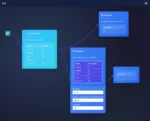
by tyler garrett | Jun 21, 2025 | Data Visual
In today’s digital-driven landscape, libraries and information centers are more than just repositories of knowledge—they’re powerful hubs of analytical insight. With extensive data accumulated through digital catalogs, borrow history, user research behaviors, and digital access information, libraries hold the key to understanding intricate information usage patterns. By visualizing these patterns, we can revolutionize librarianship and decision-making, enabling libraries to effectively curate their resources, optimize their operational efficiency, and better meet user needs. Let’s dive into how library science analytics can unlock transformative insights, propel strategic resource allocation, and reveal the hidden story within your data through intelligent visualization techniques.
Harnessing Analytics to Decode Information Usage Patterns
Traditionally, libraries relied primarily on physical checkout volumes or anecdotal observations to gauge resource utilization. However, the digital age has introduced sophisticated analytics software that significantly expands this scope. With the aid of powerful analytics tools—particularly cloud solutions like AWS which empower scalability and security—analyzing complex data sets is more accessible and efficient than ever. These advanced platforms provide opportunities to track digital resource adoption, identify seasonal trends in user behavior, and gain granular insights into user interaction with online databases or digital resources. By leveraging expert-guided platforms such as AWS consulting services, libraries can adeptly manage their analytical strategy, scaling dynamically as data grows, and extracting data-driven insights with minimal friction.
Librarians and administrators today can employ visualization tools to decode information usage in intuitive dashboards. Interactive dashboards displaying key usage metrics—for instance, peak utilization times, most commonly accessed materials or databases, and user demographics—help administrators proactively design impactful acquisition strategies. Visualization shifts the narrative from raw numbers toward insightful, understandable, and actionable representations of user behaviors, effectively optimizing library resource management and aligning decisions with genuine user needs.
The Power of Visualization – Transforming Data into Actionable Insights
Visualization bridges the gap between raw analytics and human-perceived intelligence. Leveraging well-built processes derived from data visualization methodologies, libraries can better interpret patterns, diagnose operational inefficiencies, and design interventions that enhance user engagement. Following proven frameworks, like our visualization heuristic evaluation framework, ensures visualization metrics not only accurately track informational usage but also adhere to best-practice standards for interpretability and usability. This systematic approach creates impactful visual storytelling, empowering libraries to communicate complex data clearly to stakeholders, regardless of their technical proficiency.
Interactive visualization platforms further enrich libraries’ analytical capacity, allowing users at varying skill levels to explore data independently and intuitively. Visualization makes abstract usage data tangible, enhancing decision-making for library resource planning, marketing digital materials, adjusting operational hours, or designing targeted services. Libraries that leverage interactive data exploration—following best practices such as those outlined in our article on interactive tour design for new visualization users—empower their staff to identify trends and patterns effortlessly. By enabling data-driven decisions, visual analytics dramatically elevate organizational agility, responsiveness, and service quality.
Predictive Analytics: Anticipating Needs with Demand Forecasting
While historical usage patterns shed critical insights into past and current library operations, predictive analytics introduces even greater transformative possibilities. Utilizing forecasting tools grounded in robust statistical models and machine-learning algorithms positions libraries proactively, optimizing resource allocation, inventory management, and collection building decisions. For detailed approaches and best practices, visit our resource on optimizing inventory levels through demand forecasting.
Integrating strategic demand forecasting into library management systems significantly enhances operational effectiveness. Predictive analytics helps librarians anticipate new books or digital materials that users will desire in the near future—taking into account historical usage behaviors combined with current search trends curated through analytics. This proactive approach guides librarians when deploying finite funding resources and allows libraries to meet evolving demands in a timely and impactful manner. By effectively anticipating shifts in information usage patterns, library administrators can position their institutions as highly responsive, forward-looking, and strategically innovative.
NLP and Text Analytics: Understanding Users’ Information Seeking Behavior
Beyond numeric usage data, textual and linguistic analytics open another powerful avenue for libraries. Natural Language Processing (NLP) technologies transform raw textual inputs like catalog searches, online feedback, and user-generated content into actionable insights, revealing the semantic intent behind user searches. For decision-makers unfamiliar with NLP basics, our introductory guide on the basics of natural language processing offers valuable context to further their technology strategy and innovation capability.
Applying NLP and text analytics provides libraries deeper intelligence on information seekers’ intent, preferences, and usage dynamics. For instance, sentiment analysis can measure community reactions toward particular library services or events, helping libraries adapt communication strategies proactively. Furthermore, NLP-driven keyword clustering tools can reveal browsing and content consumption trends not visible via traditional data analytics approaches. When text analytics become part of strategic planning, libraries gain unprecedented insight into users’ unique and often evolving informational requirements, further sharpening their mission and achieving greater operational agility.
Maintaining Robust Analytics: Monitoring Data Health and Reliability
Advanced analytics are valuable only if the data feeding them are healthy, reliable, and free from drift or biases. Ensuring data quality is vital; hence libraries should integrate monitoring techniques such as metric drift detection. Methods explained in our detailed guide metric drift detection: statistical methods for monitoring data health ensure continuous data reliability. These techniques allow identification and mitigation of unusual or inconsistent variations in data points over time, recognizing anomalies before they result in misguided decisions.
Effective data governance and comprehensive monitoring ensure libraries base their strategic choices—ranging from resource acquisition to altering operational hours—on reliable, current data. Building monitoring processes into analytic workflows guarantees that insights derived from visualizations and predictive models remain robust and trustworthy. Libraries accomplishing consistent data validity achieve greater accuracy from their data visualization dashboards, ultimately leading to informed, confident decision-making processes guided by analytics-driven insights.
Advanced Visualization Techniques: Visualizing Multi-Dimensional Data
Modern libraries manage expansive datasets that require more sophisticated visualization methods beyond standard two-dimensional representations. Embracing advanced models like quaternion-based visualization for higher-dimensional data helps reveal hidden relationships across various dimensions such as time, geography, demographics, and content domains simultaneously—potentially revolutionizing decision-making and insight generation.
Quaternion-based approaches, alongside other advanced statistical methods, empower libraries to perceive multidimensional usage patterns effectively. Such innovative visualization techniques assist decision-makers in examining complex interrelations of materials usage, user demographics, timeframes, and more, simplifying data complexity into visually comprehensible formats. By integrating advanced visualization methods into strategic planning, library leaders confidently manage multidimensional information, gaining a superior competitive advantage in addressing users’ unmet needs and innovatively designing services matching community aspirations.
Conclusion: Charting a New Future for Libraries with Strategic Analytics
Visualization and analytics don’t merely streamline decision-making—they redefine the librarian’s role entirely. Effective information usage visualization harnesses both traditional analytics and advanced data methods like NLP and dimensional visualization approaches to ensure libraries adapt swiftly and confidently to shifting community needs. With smart strategic deployment of reliable analytics, libraries not only understand their evolving usage patterns but anticipate and proactively respond to future user demands.
By merging strategic analytics decision-making with robust visualization techniques, library professionals become powerful data-driven leaders, shaping resilient, responsive services suited perfectly for their communities. Committed adoption of these advanced analytics methods firmly positions innovative libraries charging headfirst into future, thriving in today’s digital age.
Thank you for your support, follow DEV3LOPCOM, LLC on LinkedIn and YouTube.

by tyler garrett | Jun 21, 2025 | Data Visual
The intersection of archaeology and cutting-edge data visualization is revolutionizing how historical sites are explored, analyzed, and preserved. In an era where technological innovation propels insights, intuitive archaeological data visualization tools empower decision-makers to better understand and manage priceless cultural heritage. Imagine transforming static site maps and dense datasets into compelling visual narratives, enabling researchers and stakeholders to interactively navigate ancient ruins, explore excavation data, and visualize historical contexts more dynamically than ever before. At the forefront of this digital renaissance, sophisticated software tools leverage analytics, interactive dashboards, cloud architecture, and powerful backend solutions, such as those developed via advanced Node.js consulting services, to boost efficiency and deepen analytical capabilities. Integrating archaeology and digital technologies enhances preservation strategies, drives innovative research, and fosters data-driven insights that modern organizations and institutions depend on daily. Let’s navigate together through the visionary tools reshaping archaeological research and historical preservation strategies.
Understanding the Need for Effective Archaeological Visualizations
The discipline of archaeology generates extensive quantitative and qualitative data—detailed inventories of artifacts, spatial coordinates from excavation sites, typological analyses, stratigraphy layers, and carbon dating records. Historically, interpreting these vast datasets required painstaking, manual aggregation, processing, and detailed textual analyses. Today, however, stakeholders face growing pressure to swiftly interpret data into insightful narratives for public consumption, research, fundraising efforts, and crucial preservation decisions. With this paradigm shift, sophisticated data visualization emerges as the linchpin for effective archaeological communication, reducing complexity and facilitating comprehension for broader audiences.
By applying visualization best practices, archaeologists can transform raw data into interactive experiences, fostering a greater appreciation and enhanced understanding of historical sites. Tools incorporating aggregated analytics akin to those found in the SQL GROUP BY aggregation methods empower researchers to summarize artifact counts, spatial clustering, or temporal patterns effectively. Interactive dashboards built on powerful data infrastructure allow users to delve deeper into specific archaeological questions, such as the spatial relationships among artifacts or the chronological progression of a site’s occupation.
Additionally, visualizing archaeological data provides greater transparency in research and preservation, helping institutions bolster advocacy, secure funding, and align diverse stakeholders. Indeed, effective visualization has transitioned from a nice-to-have to a strategic requirement, driving decision-making processes across archaeological and heritage management sectors.
Leveraging Advanced Technologies: Interactive Dashboards and Spatial Analytics
Interactive dashboards and advanced spatial analytics represent new frontiers in archaeological analysis, dramatically reshaping traditional research approaches. Solutions that employ progressive web applications, interactive maps, and spatial analytical methods—such as geospatial data systems supported by Node.js backend frameworks—are enabling deeper site investigation and enhanced interpretability of archaeological data.
Progressive data loading, a critical advancement discussed in our recent guide, Progressive Data Loading for Responsive User Interfaces, allows historians and archaeologists quick access to archaeological data visualizations, streamlining the analytical process and improving user engagement. Interactive mapping layers provide dynamic visual contexts, allowing researchers to match historical records against physical spatial data to uncover previously invisible relationships and patterns. Furthermore, responsive dashboards deliver data insights efficiently, no matter the underlying dataset complexity or dataset size.
Advanced analytic techniques, such as the utilization of SQL’s logical operators (thoroughly detailed in our article Harnessing the Power of Logical Operators in SQL), empower archaeologists to query robust datasets effectively, filtering spatial data to reveal complex site patterns or artifact distributions. By embracing cloud-based analytical platforms with event-driven architectures, archaeologists expedite data-driven decision-making and progressive insight discovery, fostering deeper analytical understanding and preserving scientific rigor.
Seamless Integration of Legacy Archaeological Data and Modern Visualization Tools
Despite the massive benefits contemporary visualization tools offer, archaeological projects frequently face challenges surrounding legacy data integration. Historical datasets compiled over decades—sometimes recorded manually or stored in outdated formats—pose integration hurdles for modern analytical and visualization platforms. Strategic innovation inside legacy environments becomes vital, as explained in our insightful piece on how to innovate inside legacy systems without replacing them. Applying thoughtful modernization methodologies enables archaeologists and heritage managers to seamlessly integrate historical data into contemporary tools, retaining essential context while unlocking new analytical possibilities.
Implementing a hybrid data architecture guided by proper inter-company data sharing governance frameworks ensures secure, compliant, and efficient transfer of historical datasets, elevating data transparency and traceability across institutional boundaries. By establishing best practices for Change Data Capture (CDC) implementation—a topic extensively explored in our article on Change Data Capture topologies for event-driven analytics—archaeologists can systematically migrate legacy systems into modern analytical environments without significant disruption or loss.
Utilizing this smart modernization approach, site managers and analysts enhance visibility and accessibility of archaeological data, achieving insightful historical analyses that benefit academic research, stakeholder interests, and public engagement alike.
Maximizing Return on Investment with Innovative Data Visualization
Financial sustainability is an essential consideration within archaeology; therefore, investing strategically in visualization tools should yield measurable returns. Visualization technologies significantly enhance stakeholder understanding, driving funding, guiding policymaking, and improving site management—ultimately benefiting organizations’ strategic and financial goals. In fact, archaeological institutions that embrace data engineering trends and innovations noted in our recent future-focused article Boost Profitability with Data Engineering Trends in 2025 position themselves for enhanced efficiency, improved outcomes, and stronger financial health.
Thoughtful solutions like Tableau, which offer flexible visualization capabilities adaptable across diverse archaeological datasets (review our detailed breakdown of Tableau pricing), allow organizations to rapidly demonstrate analytical ROI by reducing response times, improving decision accuracy, and facilitating effective communication. Moreover, institutions gain financial insights enabling better site management, resource allocation, and targeted project development—strengthening the case for funding bodies and governmental support agencies.
Strategically adopting powerful data visualization solutions combined with rigorous data analytics best practices ensures optimal value extraction from archaeological data, improving financial sustainability, enhancing stakeholder engagement, and driving forward mission-critical objectives.
Future Perspectives: Transforming Archaeology with Data-Driven Innovation
The future of archaeological research and heritage site management hinges significantly on robust digital innovation and data-driven practices. Historical site analysis tools increasingly rely on sophisticated backend technologies such as Node.js and tailored analytical systems to enable responsive, real-time visualizations and deeper insights. On the horizon are untapped possibilities—virtual reality integrations, augmented reality explorations, machine-learning-driven artifact recognition and predictive site analysis—that promise significant breakthroughs for archaeological research and public engagement.
Collaborative platforms and a data-focused culture shift within archaeology facilitate broader data accessibility, improved analytical workflows, and richer historical storytelling. Utilizing expert software consulting partnerships, organizations can strategically adapt and rapidly integrate these emerging technologies, placing archaeological research at the forefront of digital innovation. This innovative infrastructure, supported by efficient backend frameworks like Node.js, enables seamless scalability and flexibility, crucial for future-proofing archaeological research and visualizations efforts.
Ultimately, the adoption and implementation of sophisticated archaeological data visualization tools provide the foundation for remarkable innovation and transformative outcomes. Decision-makers equipped with modern tools foster responsible site management practices, amplify public engagement, improve research transparency, and ensure long-term preservation—establishing archaeology as a model sector in technology-driven innovation and insightful analytics.
Thank you for your support, follow DEV3LOPCOM, LLC on LinkedIn and YouTube.

by tyler garrett | Jun 21, 2025 | Data Visual
Unlocking the power hidden within museum visitor analytics isn’t just a technical possibility—it’s a cultural imperative. Modern museums aren’t just caretakers of human heritage; they are active hubs adapting to digital transformation. As visitor data analytics evolve, institutions gain deeper insights into audience behavior, driving innovative exhibits, tailored outreach, and enhanced visitor experiences. Leveraging powerful tools like visualization dashboards, advanced analytics, and cloud solutions can amplify these insights further. At the intersection of culture and data technology, we stand ready to equip museum executives and curators with the strategic insights they need to navigate, decision-make, and thrive in an era of digital disruption.
Why Visitor Analytics Matters for Cultural Institutions
Museums and cultural landmarks operate in environments rich with complex data—from ticket sales and visitor footfall statistics, to exhibit engagement and digital interactions. However, the real challenge often lies not in collecting data, but in transforming it into informed, actionable insights. Visitor analytics bridges this critical gap, allowing museums to deeply understand their audience and make strategic decisions to improve experiences, streamline operations, and maximize cultural impact.
Visitor analytics empowers decision-makers, helping them identify popular exhibits, peak visitor hours, demographic preferences, and even visitor journey patterns. With data-driven insights, museums can finely tune their offerings, creating a more engaging experience tailored for diverse visitor groups. This strategic advantage not only attracts more visitors but also enhances visitor satisfaction and loyalty—critical metrics for long-term institutional sustainability.
Moreover, comprehensive visitor analytics reveals drivers behind visitor behaviors and preferences, thus leading to improved communication and targeted marketing strategies. Utilizing data visualization techniques allows institutions to quickly interpret trends, communicate findings comprehensively, and strategize around emerging opportunities and challenges effectively.
Powerful Visualizations for Engaging Storytelling
One of the greatest advantages of museum visitor analytics is its ability to tell compelling stories visually, simplifying complex data into understandable formats that resonate with diverse stakeholders. Museums are inherently visual and experiential institutions—it’s only natural to translate their operational and visitor data into dynamic visualizations that clarify insights, invite collaboration, and enhance internal decision-making processes.
Modern data visualization tools such as Tableau or Power BI offer opportunities to create accessible dashboards, incorporating features like interactive maps, heatmaps, visitor flow diagrams, and more. Dashboards can effortlessly illustrated things like peak visitation days, demographics, and exhibit visit comparisons, facilitating superior decision-making across departments such as marketing, operational management, and curatorial teams. To go further in-depth, museums can benefit from automated solutions, like Tableau Server Automated Dashboard Images, reducing manual effort and streamlining routine reporting tasks.
A good visualization tool transcends graphical appeal. Understanding the purpose of your visualization and its intended audience is crucial to delivering insights effectively. Is it meant for internal department heads, external partners, or a general public-facing portal? Strategic visualization ensures your insights land clearly and generate the intended actionable responses.
The Tech Behind the Analytics: Robust Infrastructure and Scalability
Behind visually engaging dashboards and actionable insights is a solid technical infrastructure. Visitor analytics requires reliable data storage, efficient processing capabilities, scalability, and security—all areas where modern cloud solutions shine. Many cultural institutions leverage cloud infrastructure and services such as AWS to ensure robust, scalable, and secure data solutions. With tailored AWS consulting services, museums can leverage robust cloud architectures designed to optimize performance, mitigate risks, and enhance scalability as the data environment expands.
Additionally, adopting strategic systems integration approaches helps museums effectively manage data coming from multiple sources including ticketing systems, mobile apps, interactive displays, CRM tools, and website analytics. To create unified visibility of customers’ data journeys, organizations benefit from applying tested practices of master data management and integration patterns. Correct system integration ensures data accuracy, real-time synchronization, reduced redundancy, and increased reliability of analytics reporting.
The technology behind visitor analytics is undeniably advanced, from embedding custom analytics queries utilizing SQL statement best practices discussed in our guide on demystifying SQL FROM clauses, to employing AI-driven recommendations or text analytics. Optimizing technical resources— like choosing appropriate storage options and evaluating vector database selection criteria—ensures scalable, future-proof analytics strategies that evolve seamlessly with your institution’s needs.
Accessibility and Inclusion through Thoughtful Data Visualization
Creating valuable visitor analytics goes beyond technical competencies—it involves ensuring information is equally accessible for all stakeholders. Museums typically pledge toward inclusive, equitable visitor experiences; this mission should extend seamlessly into their data visualization practices. Accessible data visualizations ensure clear comprehension and utility for every audience member, including persons with disabilities. Thoughtful visualization involves considerations like color contrast, text readability, and alternative textual descriptions, aligning perfectly with institutional commitments to inclusivity and equity.
Developing accessible visualizations doesn’t mean sacrificing depth or complexity of analysis. In fact, intentionally designed inclusive visuals amplify clarity and can increase usability across multiple user groups. Our consultancy steadfastly emphasizes designing dashboards and visuals with universal accessibility principles integrated right from the beginning. Our detailed guide, Creating Accessible Data Visualizations for All Users, outlines crucial best practices, helping museum tech teams deliver clearer communication while supporting the broader institutional goals of inclusion and community building.
Inclusive data visualizations empower culturally diverse communities, encourage broader user engagement, and ultimately increase impact through the ethical presentation of information. Consider making this critical improvement a cornerstone of your analytics practice, strengthening trust, engagement, and data-driven decision-making capability throughout your organization.
Shaping Museum Experiences through Strategic Analytics Investment
Ultimately, integrating visitor analytics and data visualization effectively positions cultural institutions at the forefront of innovation, driving strategic decisions across exhibitions, general operations, and audience interaction strategies. Insightful analytics empower institutions to proactively identify and respond to changing visitor needs, support effective resource allocation, and solidify their cultural significance in the digital age.
The possibilities are boundless—from leveraging predictive analysis to forecast visitor trends, tailor marketing, and prepare proactive exhibition strategies, to harnessing real-time analytics to improve immediate visitor experiences. This strategic investment enhances museums’ capabilities to adapt to the evolving cultural consumption behaviors in an increasingly digital-first environment.
Our software consultancy, specializing in analytics, innovation, and cloud solutions, stands prepared to guide your cultural institution through every stage, from foundational data infrastructure planning to advanced dashboarding and data-driven strategic advisory. By harnessing museum visitor analytics strategically, cultural institutions can craft richer visitor experiences, reinforce their cultural mission, and safeguard future relevancy in a data-driven world.
Museum analytics isn’t just about numbers; it’s about creating deeper connections and delivering memorable, impactful experiences to every visitor who walks through your doors.
Thank you for your support, follow DEV3LOPCOM, LLC on LinkedIn and YouTube.

by tyler garrett | Jun 21, 2025 | Data Visual
The moment disaster strikes, decision-making velocity can mean the difference between recovery and catastrophe. Emergency responders rely heavily on actionable insights driven by clear, real-time visualizations tailored to crisis contexts. Enter emergency management dashboards—interactive analytic tools specifically crafted to transform raw disaster response data into dynamic, coherent visuals. These dashboards empower responders with critical situational awareness, optimizing decision-making speed and effectiveness. From centralizing complex data streams during hurricanes to pinpointing infrastructure impacts after earthquakes, the power of innovative dashboards cannot be overstated. Let’s dig into how emergency management dashboards bolster strategic disaster response through intelligence, integration, and cutting-edge analytics.
Why Dashboards are Essential in Disaster Response Management
In emergency scenarios, data overload can be just as detrimental as data scarcity. Complex situations demand rapid interpretation of vast amounts of information—often multidimensional and arriving at unprecedented rates. Dashboards serve as the command centers that deliver contextual clarity, bringing order to data chaos. By visually synthesizing real-time sensor inputs, responder reports, Geographic Information Systems (GIS) data, and predictive analytics, these dashboards empower human decision-makers to comprehend, prioritize, and act with clarity and decisiveness.
Robust visualization platforms not only summarize information but also reduce cognitive strain by presenting crisis-relevant data clearly and intuitively. Consider the dense data produced during hurricanes or flooding. Dashboards transform that overload into actionable insights with intuitive representations that include resource tracking, impacted area mapping, and real-time alerts—creating an information advantage crucial to effective disaster response. Well-designed dashboards encapsulate this technological edge, establishing the foundation for teamwork, informed resource allocation, and successful outcomes amidst chaos.
Furthermore, quality dashboards enable responders to visualize complex data relationships quickly. Incorporating advanced visualization methods like sparkline charts or geographical maps leverages spatial analytics, providing rapid visualization layers essential to making informed operational decisions. Thus, emergency dashboards are not just desirable—they’re essential to managing dynamic, life-critical events.
Core Components of Effective Emergency Management Dashboards
To achieve real-time tactical advantages, emergency dashboards need strategic component designs. The fundamental aim is to deliver high-value insights while maximizing readability and interactivity. Dashboard components typically include real-time data feeds, spatial visualization maps, predictive forecasting analytics, resource tracking visualizations, and intuitive user interaction capabilities.
A sophisticated emergency dashboard integrates live sensor data streams, enabling responders to monitor rapidly changing dynamics—factors such as weather conditions, water levels, seismic activities, energy supply disruption. The implementation of effective real-time input validation strategies for data streams ensures the accuracy of these dashboards, reducing the chances of false positives or negatives that can mislead critical response efforts.
Spatial mapping capability represents another fundamental component. Geographic Information Systems integration makes it possible to visualize critical incidents or affected populations geographically. Such clarity improves responders’ ability to dispatch resources effectively, prioritizing areas requiring immediate responses. Leveraging predictive analytics within the dashboards can help anticipate needs and proactively position resources to mitigate future impacts.
Additionally, intuitive interaction capabilities and actionable alerts empower field personnel, enabling instant drill-downs into critical data categories like resource inventories, staffing deployments, or affected populations. Dashboards equipped with interactive drill-down experiences free responders from static visuals, allowing fine-tuned inquiries into situational specifics on-demand.
Incorporating Analytics and AI into Emergency Response Visualization
The evolution of emergency management dashboards now includes sophisticated analytical techniques and artificial intelligence (AI). Integrating AI-driven predictive modeling helps anticipate potential impacts, improve resource allocation, and streamline response strategies. At Dev3lop, we leverage our extensive AI Agent Consulting Services to develop dashboard solutions that proactively identify risk areas, evaluate preventive scenarios, and advise human decision masters with data-backed confidence.
Machine learning algorithms can analyze pre-disaster historical data patterns and extract insights from past crisis situations, enabling organizations to foresee impending hazard trends. Pairing machine-driven analytics with robust visualization dashboards presents these predictive capabilities for decision-makers via user-friendly graphics. AI-enhanced dashboards display forecasted threats visually, enabling better preparedness, strategic positioning of assets, and optimized response timing.
Additionally, real-time anomaly detection algorithms detect emerging or unplanned scenarios swiftly, generating timely alerts directly within dashboards. Visualizing these analytical outcomes through accessible interfaces ensures that decision-makers grasp the severity, impact scope, and suitable actions promptly. The elevation of emergency dashboards with analytical sophistication is crucial for any organization serious about disaster resilience, advanced preparation, and timely response strategies.
Securing and Trusting Disaster Response Data
While data-driven dashboards bring significant advantages, they are only as powerful as the trustworthiness, accuracy, and security of their underlying data. Disaster response frequently involves sensitive data sharing among agencies—requiring effective implementation of robust data security and trust frameworks. Deploying a strategic data trust implementation framework assures secure, transparent data transactions amongst stakeholders, reinforcing collaborative disaster response without compromising confidentiality and compliance.
Dashboards handling protected and sensitive information benefit significantly from implementing fine-grained attribute-based access control, permitting disciplined information access based on clearly established roles and privileges. Access control safeguards assure secure, confidential usage of data visualizations by authorized personnel only, maintaining information integrity under stressful and dynamic conditions.
Furthermore, emergency dashboards can leverage comprehensive data retention policies and robust audit trails. By ensuring clarity around what data is preserved, for how long, and under what compliance constraints, emergency agencies enhance data legitimacy, quality, and regulatory adherence—critical in disaster scenarios where compliance standards are strict and data provenance crucial.
Future-Proofing Your Dashboards Through Data Governance
Dashboards that perform superbly today must remain effective tomorrow. Future proofing hinges on rigorous data governance, ensuring data consistency, reliability, and adaptability over long-term usage. Agencies tackling emergencies can benefit immensely from establishing systematic governance protocols, including maintaining data element cross-reference registries, establishing controlled vocabularies and consistent terminologies that persistently fuel dashboard reliability and accuracy into the future.
Sophisticated data governance also incorporates clearly documented standards and best practices. Dashboards must remain flexible and adaptive, capable of integrating new data sources, emerging analytical technologies, and shifting organizational structures. When governance protocols are strong, dashboards can easily incorporate innovations—such as new APIs, sensor technologies, or analytics modules—minimizing disruptions to established data workflows and maintaining focus on delivering critical actionable insights.
Data governance combines meticulous technological cataloguing practices with well-defined roles and clearly communicated responsibilities. By explicitly defining how information is managed across the dashboard lifecycle, agencies embed clarity that cascades into operational excellence. Universities and academic partners, like The University of Texas at Austin, continue to deliver highly-trained data professionals proficient in advanced visualization and data governance, reinforcing dashboards’ longevity and efficacy as a critical emergency management asset.
Visualization Dashboards: The Cornerstone for Effective Emergency Management
Strategically designed and intelligently implemented dashboards revolutionize disaster response by delivering critical insights at the precise moment they are needed most. Integrating cutting-edge technologies, analytics, AI-driven predictions, and secured data sharing, these emergency management dashboards empower responders to act fast, effectively, and with maximum efficiency.
At Dev3lop, our specialists translate complex data and analytics into intuitive, high-impact dashboard solutions. Leveraging cutting-edge analytics and extensive experience designing sophisticated, strategic dashboards, we help organizations secure resilience, optimize resource utilization, and mitigate impacts through powerful visualization. Disaster response visualization dashboards are not just visual aids—they have become indispensable command centers crucial in moments when every second could make all the difference.
Thank you for your support, follow DEV3LOPCOM, LLC on LinkedIn and YouTube.

by tyler garrett | Jun 21, 2025 | Data Visual
The political battlefield has undeniably shifted toward data-driven decisions. Understanding voter behavior is no longer just about surveys and polls; it’s about leveraging sophisticated analytics tools and visualization systems to reveal hidden insights. At a time when campaigns are won or lost by razor-thin margins, harnessing data analytics and visualization can mean the difference between victory and defeat. Every interaction, preference, and behavioral indicator provides valuable clues for strategists eager to craft compelling narratives, targeted outreach campaigns, and persuasive voter engagement strategies. With advanced technology, candidates and political decision-makers are no longer in the dark—they understand exactly what voters crave, expect, and ultimately, the reason they step into the ballot box.
The Rise of Data Visualization in Political Campaigns
Gone are the days when voter behavior analytics were confined to spreadsheets, tedious cross-tabulations, or manual data analyses. Today’s campaigns need real-time insights presented clearly and intuitively, which is why data visualization systems have become indispensable for political strategists. The visualization of voter behavior data has immensely facilitated better campaign decision-making, enabling strategists to instantly map demographic interests, track voting preferences, and predict electoral outcomes with greater accuracy.
A robust voter behavior visualization system comprises intuitive dashboards, real-time data streaming, and interactive graphical representations such as heat maps, bar charts, and scatter plots. These visualizations can display data segmented by geography, age, income, previous voting history, and socioeconomic status—with just a few mouse clicks. Consequently, campaigns can strategically allocate their resources to clearly identified voter segments rather than spreading out their efforts randomly.
Additionally, visual analytics allow campaign managers to seamlessly explore voter concerns, sentiment analyses, and cross-demographic synergies. For example, interactive charts can illustrate how voter preferences within one age bracket compare with preferences within another, helping political marketers better fine-tune their messages. When visualized effectively, data trends become immediately actionable insights, helping decision-makers understand quickly changing voter environments. This cross-modal data alignment enhances the integration of multiple data inputs and supports unified analytics views across complex campaign environments.
The Role of Advanced Data Integration in Campaign Analytics
Successful political analytics depends on robust data integration capabilities. Campaign teams encounter vast amounts of voter data—everything from public demographic records and surveys to voting histories, digital engagement platforms, and social media trends. Aggregating and harmonizing these varied data streams is crucial to forming a cohesive narrative and driving strategic campaign decisions.
To overcome fragmented data challenges, innovative campaigns utilize complex ETL (extract, transform, load) workflows and advanced data integration techniques, including asynchronous ETL choreography. Adapting advanced analytical methods enables campaign strategists to operate beyond traditional data processing confines, integrating real-time insights and asynchronous data streams seamlessly to produce timely, accurate voter metrics.
Handling sensitive voter information demands secure and compliant methodologies. Modern voter behavior visualization systems incorporate sophisticated test data management techniques, ensuring personally identifiable, sensitive data remains anonymized and secure while maintaining analytical utility. This delicate balance between data privacy and strategic insight underscores the sheer ingenuity involved in modern voter analytics.
Implementing security mechanisms like multi-party computation for secure analytics helps campaign teams ensure voter confidentiality, fostering trust between campaign teams and constituents. In an age increasingly mindful of privacy and data security, maintaining robust analytics without compromising individual privacy provides a significant competitive advantage.
Harnessing AI and Machine Learning for Predictive Campaign Insights
The true transformative power behind political campaign analytics is derived from applying cutting-edge AI and machine learning technologies. Predictive analytics and advanced modeling techniques allow campaign managers to forecast voting behaviors, sentiments, and election results with higher precision and confidence. Machine learning algorithms can analyze historical voting patterns, current demographic changes, and trending topics to generate accurate, reliable predictions of voter intent.
AI-driven analytics visualize potential voter enthusiasm factors—ranging from economic issues and healthcare concerns to education initiatives and social justice topics. Strategists can utilize actionable visualization of insights around voter communities most likely to support certain policy positions, which aids targeted canvassing and digital outreach.
Furthermore, by leveraging vector embedding pipeline designs, campaign visualization systems become semantically intelligent, capable of understanding voter sentiment, complex language, and subtle preference shifts. This capability allows campaigns to predict how certain voter segments may respond to messaging, policy framing, or debate performances. These depth-oriented prediction models allow candidates to preemptively react to potential voter shifts, adjusting campaign strategies dynamically based on robustly analyzed visual data.
Empowering Voter Behavior Visualization with Effective Text Integration
Beyond standard visualization features such as charts, maps, and graphs, leading-edge voter behavior analytical systems integrate effective textual elements to enhance user engagement, storytelling capabilities, and actionable insights. Text integration in data visualization becomes more than a simple labeling mechanism—it conveys detailed context, insights, and even persuasive narratives designed to capture a voter’s attention or communicate analytics insights to campaign stakeholders efficiently.
Whether incorporated as dynamic annotations explaining voter interaction trends or descriptive narratives that contextualize regional survey data, quality text integration enriches the visualization user experience. When software empowers campaign teams with interactive storytelling capacities, complex voter trends are easily distilled for strategic decision-making.
Interactive text annotations and dynamic visual cues provide instant clarity where voter communities diverge, allowing strategists to shift resources, refocus social media campaigns, or even reframe message framing to better resonate with targeted demographics. Enhanced textual visualization is thus essential in ensuring political analytics are both actionable and intuitively understood by decision-makers within tight campaign timelines.
Data Governance and Visualization Metrics: Ensuring Quality and Trustworthiness
With immense influence, political data analytics must maintain rigorous standards. Accurate voter behavioral insights require precise, high-quality data, which inevitably places data governance and metric collection front and center for any successful visualization implementation. Governance strategies define how voter data quality should be controlled, maintained, and monitored, ensuring campaigns base decisions on highly reliable, transparent, and accountable insights.
Campaign strategists must implement structured data governance strategies to monitor visualization accuracy, data lineage, and metric consistency. Clear data governance policies promote trustworthiness and reliability of campaign analytics insights. It ensures correct voter segmentation, engagement statistics, and electoral predictions—elements crucial to campaign direction.
Ultimately, governance maintains long-term integrity in voter strategy visualizations, empowering campaigns to explore voter engagement, pinpoint geographic outreach areas, target demographic messaging, and extract predictive insights with absolute confidence. It solidifies organizational accountability, transparency, and ethical handling—key operational success standards in today’s highly scrutinized political analytics environment.
The Future of Voter Behavior Visualization Systems
As campaigns evolve and become more technologically advanced, frameworks like the data lakehouse implementation promise to become industry mainstays for large-scale data management and analytics in political contexts. Voter behavior data lakes or lakehouses enhance scalability and flexibility of integrating real-time voter behavioral information, community feedback, surveys, and digital interaction data.
Visualization systems will continuously become smarter, embracing advanced semantic technologies, predictive targeting, secure computations, and more refined textual annotations. Political campaigns willing to embrace innovative visualization approaches and analytics solutions will realize a transformative competitive advantage.
At Dev3lop, we hold expertise across data and analytics technologies, including Microsoft SQL_SERVER, supporting robust and scalable analytical environments. Intelligent, visually compelling analytics will profoundly shape future political strategies, enabling smarter decisions, clearer insights, and direct voter engagement. The visualization revolution is well underway—and successful campaign strategists will not hesitate to embrace it.
Thank you for your support, follow DEV3LOPCOM, LLC on LinkedIn and YouTube.





























